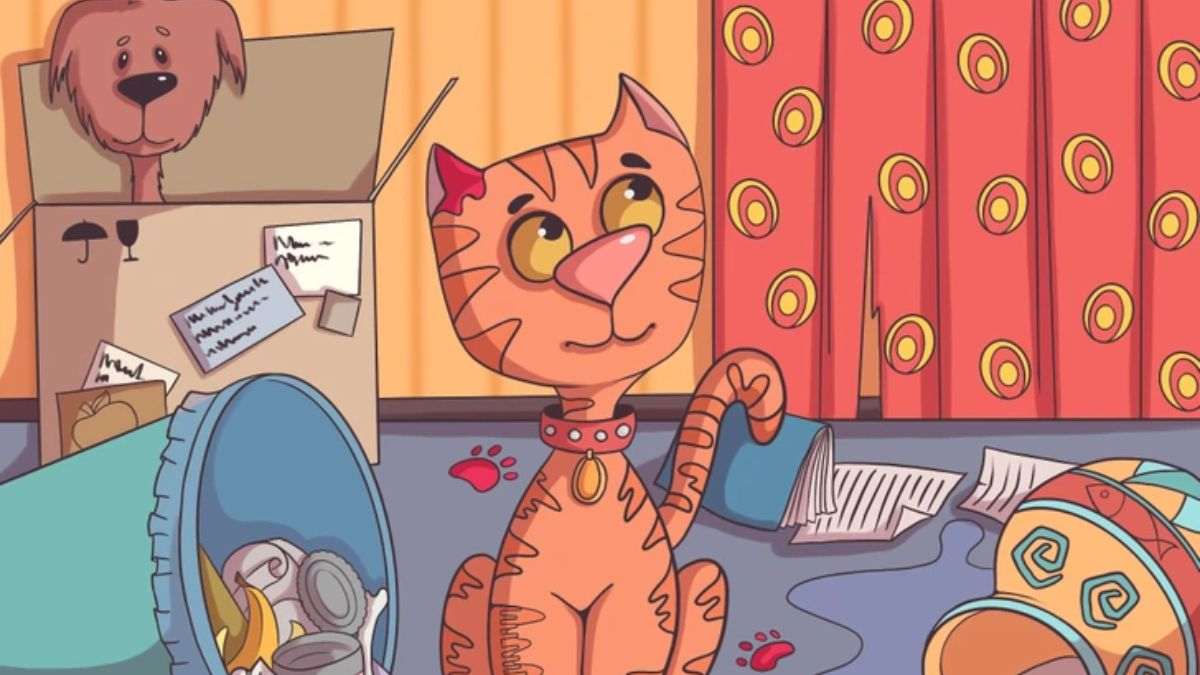In the realm of cognitive assessments, IQ tests have long been a staple for measuring intelligence and problem-solving abilities.
However, in recent years, a new breed of IQ-testing methods has emerged, incorporating elements of visual perception and spatial reasoning.
One such innovation is the “It’s Raining Dogs and Cats!” optical illusion, designed to challenge the mind in novel ways.
This article delves into the intricacies of this illusion, exploring its underlying principles and decoding the secrets hidden within its enigmatic imagery.
Understanding the Illusion:

At first glance, “It’s Raining Dogs and Cats!” appears to be a whimsical scene of falling pets against a backdrop of clouds.
However, closer inspection reveals a hidden element within the image—an elusive bone waiting to be discovered.
The challenge lies in spotting this concealed object amidst the flurry of furry creatures, all within a timeframe of just 11 seconds.
The illusion capitalizes on the brain’s propensity for pattern recognition and visual processing.
By presenting a complex visual stimulus, it prompts the viewer’s cognitive faculties to engage in rapid analysis and decision-making.
The time constraint adds an element of urgency, heightening the pressure to perform under duress—a hallmark of many IQ tests.
Analyzing the Elements:
To unravel the mystery of the hidden bone, it is essential to dissect the various components of the image.
Each element contributes to the overall illusion, shaping the viewer’s perception and influencing their ability to discern the secret object.
Composition: The composition of the image plays a crucial role in directing the viewer’s attention.
The falling dogs and cats create a dynamic visual flow, drawing the eye towards the center of the scene where the bone is concealed.
However, the surrounding clouds and sky add complexity, obscuring the bone amidst a sea of visual stimuli.
Contrast: Contrast is key to highlighting the hidden object within the image.
The bone is strategically positioned against a backdrop of darker clouds, enhancing its visibility and creating a focal point for the viewer.
This contrast facilitates rapid identification, allowing the bone to stand out amidst the chaos of falling pets.
Scale and Proportion: Scale and proportion contribute to the illusion’s overall coherence and believability.
The size of the dogs and cats relative to the bone creates a sense of depth and perspective, imbuing the scene with a semblance of realism.
However, this realism is tempered by the exaggerated scale of the pets, adding a whimsical twist to the imagery.
Color and Texture: The use of color and texture further enhances the illusion’s visual impact.
The vibrant hues of the pets contrast sharply with the muted tones of the sky, creating a visually striking tableau.
Additionally, the texture of the clouds adds depth and dimension to the scene, enriching the viewer’s sensory experience.
Deciphering the Strategy:
To successfully navigate the “It’s Raining Dogs and Cats!” illusion, viewers must employ a strategic approach that combines perceptual acuity with rapid decision-making.
Several techniques can aid in this endeavor:
Peripheral Vision: Peripheral vision can be a valuable asset when scanning the image for hidden objects.
By expanding their field of view beyond the central focal point, viewers can increase their chances of detecting the elusive bone lurking in the periphery.
Gestalt Principles: Gestalt principles of visual perception, such as figure-ground segregation and closure, can guide viewers in parsing the image’s underlying structure.
By mentally organizing the elements of the scene into coherent patterns, viewers can uncover hidden relationships and identify the secret object more effectively.
Mental Rotation: Mental rotation involves mentally manipulating spatial representations to facilitate object recognition.
By mentally rotating and reorienting the image, viewers can gain new perspectives on its composition, potentially revealing hidden elements that were previously obscured.
Pattern Recognition: Pattern recognition is central to the task of identifying the bone within the image.
Viewers must quickly scan the scene for familiar shapes and configurations, leveraging their innate ability to discern meaningful patterns amidst the visual noise.
Conclusion:
In the realm of IQ testing, optical illusions offer a unique and engaging way to assess cognitive abilities.
The “It’s Raining Dogs and Cats!” illusion exemplifies this approach, challenging viewers to unravel its visual enigma within a limited timeframe.
By understanding the underlying principles of the illusion and employing strategic perceptual strategies, viewers can enhance their performance and unlock the secrets hidden within its whimsical imagery.
In the quest for intellectual mastery, perhaps it truly does rain cats and dogs—and the occasional bone of insight.
